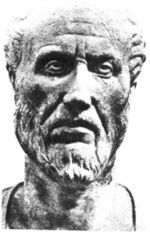Philosophy:Okhema
| Part of a series on |
| Neoplatonism |
|---|
 |
Script error: The function "transl" does not exist. (Ancient Greek:) refers to the "carrier" or "vehicle" of the soul (Script error: The function "transl" does not exist.), serving as the intermediary between the body and the soul, in Neoplatonism and the philosophical traditions it influenced.[1]
Background
Neoplatonism is a branch of classical philosophy that uses the works of Plato as a guide to understanding religion and the world. In the Myth of Er, particularly, Plato rendered an account of the afterlife which involved a journey through seven planetary spheres and then eventual reincarnation. He taught that man was composed of mortal body, immortal reason, and an intermediate "spirit".[2] Neoplatonists agreed as to the immortality of the rational soul but disagreed as to whether man's "irrational soul" was immortal and celestial or whether it remained on earth and dissolved after death.[3][verification needed]
Proclus
Building on concepts described by Iamblichus and Plotinus, the late Neoplatonist Proclus posited two "carriers" of the soul:[4][5][6][3]
- the Script error: The function "transl" does not exist., or the "luminous vehicle" of the rational soul, which he identified as the immortal vehicle of the soul.
- the Script error: The function "transl" does not exist., or the "pneumatic vehicle" of the irrational soul aligned with the vital breath (Script error: The function "transl" does not exist.), which he considered mortal.
Influence
The Neoplatonic Script error: The function "transl" does not exist. was influential to Renaissance occult thought regarding the body of light and 19-century thought regarding the astral body.
See also
References
- ↑ Griffin (2012).
- ↑ Plato (2007).
- ↑ 3.0 3.1 Dodds (1963), Appendix.
- ↑ Shaw (2013).
- ↑ Griffin (2012), p. 162, 178, 181.
- ↑ Dillon (1990).
Sources
- Dillon, John (1990). "Plotinus, the First Cartesian?". Hermathena (149): 19–31. ISSN 0018-0750.
- Dodds, E.R. (1963). Proclus: The Elements of Theology. A revised text with translation, introduction, and commentary. (2nd ed.).
- Griffin, Michael (2012). "Proclus on Place as the Luminous Vehicle of the Soul". Dionysius 30: 161-186. https://www.academia.edu/4480794/Proclus_on_Place_as_the_Luminous_Vehicle_of_the_Soul.
- Plato (2007). The Republic (2nd ed.). London: Penguin. ISBN 978-0140455113.
- Shaw, Gregory (2013). "Theurgy and the Platonist’s Luminous Body". in DeConick, April; Shaw, Gregory; Turner, John D.. Practicing Gnosis. pp. 537–557. doi:10.1163/9789004248526_029. ISBN 9789004248526.
Further reading
- Corrias, A. (2013). "From Daemonic Reason to Daemonic Imagination: Plotinus and Marsilio Ficino on the Soul’s Tutelary Spirit". British Journal for the History of Philosophy 21 (3): 443–462. doi:10.1080/09608788.2013.771608.
 |

